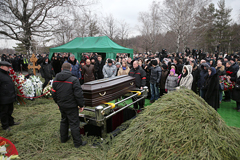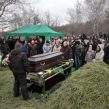
The Murder of Boris Nemtsov: An Unsolved Conspiracy
Publication: Eurasia Daily Monitor Volume: 12 Issue: 41
By:

Boris Nemtsov (55), former governor of Nizny Novgorod, former deputy Duma speaker, deputy prime minister under President Boris Yeltsin and, more recently, an opposition leader and vocal critic of President Vladimir Putin, was gunned down last Friday night, February 27, in downtown Moscow, just a hundred meters from the Kremlin (see EDM, March 2). Tens of thousands protested Nemtsov’s slaying; his funeral was attended by foreign dignitaries, but not President Putin or Prime Minister Dmitry Medvedev (Interfax, March 3). In a telegram of condolences, Putin promised to find and punish the “organizers and executors of this foul and cynical crime” (Kremlin.ru, February 28). This week, speaking to a gathering of the top brass of Russia’s police force, Putin, among other things, mentioned the Nemtsov assassination: “Russia must be finally delivered from humiliation and tragedy, like the one we have just recently suffered—the impudent killing of Nemtsov in the center of the capital” (Kremlin.ru, March 4).
Nemtsov had publicly denounced the annexation of Crimea and Russia’s involvement in the fighting in the Donbas region of southeastern Ukraine. The pro-Kremlin NTV channel recently announced a special investigative program to be aired on Sunday, March 1, disclosing Nemtsov as a Western agent, who “organized the Maidan in Kyiv”—the popular uprising that overthrew the pro-Russian Ukrainian leader Viktor Yanukovych in February 2014. After Nemtsov’s murder, the airing of the program—“The Anatomy of Protest 3”—was postponed indefinitely by NTV, without a public explanation (Moskovsky Komsomolets, February 28).
Quoting leaks from investigators, the Lifenews portal, known to have close connections to the Kremlin, the Russian police and special services, alleges that Nemtsov spent most of his last day alive with his Ukrainian girlfriend Anna Duritskaya. Nemtsov met Duritskaya at the Sheremetyevo airport at 11 a.m., as she arrived by plane in Moscow from Kyiv. Nemtsov’s SUV was reportedly clandestinely followed out of the airport by first one and then another surveillance car, up to his apartment in downtown Moscow, close to the Kremlin, according to surveillance camera data. In the afternoon, Nemtsov was interviewed in the studio of Ekho Moskvy Radio in central Moscow. Later, he apparently spent time with Duritskaya at a cafe on Red Square, opposite the Kremlin. Nemtsov, reportedly, dismissed his personal driver along with the SUV. After 11 p.m., the couple decided to walk the relatively short distance from Red Square to Nemtsov’s apartment, instead of taking a cab. Evidently, the killer then swiftly drove onto a bridge spanning the Moskva River, intercepted Nemtsov there, shot him six times in the back (four hits), and got into a getaway car that pulled up at the murder scene. Nemtsov collapsed and, apparently, died practically instantly, Duritskaya was unharmed. The killer and the getaway car disappeared from the scene of the crime (Lifenews, March 3).
Nemtsov’s assassination was, by all preliminary accounts, a well-organized operation, involving extensive surveillance by possibly dozens of individuals in the center of Moscow on Red Square, close to the Kremlin. The surveillance was carried out in a highly professional manner: Duritskaya told reporters she did not notice anything strange before the hit (Interfax, March 2). After several days of questioning, Duritskaya refused to enter a witness protection program and was allowed to leave for Kyiv. She did not attend Nemtsov’s funeral (Interfax, March 3).
According to Russian security specialists, the surveillance operation that preceded Nemtsov’s assassination may have lasted several weeks. The operatives who prepared and executed the murder were almost certainly special service professionals, who know the routines of regular Russian special services. Red Square and the vicinity of the Kremlin are among the most guarded places in Russia, constantly patrolled and observed by police, special service agents and surveillance cameras. The operatives that were preparing the assassination of Nemtsov could have been using special communications equipment to avoid detection, as they were coordinating the activity of different surveillance and hit teams in the close vicinity of the Kremlin complex (Komsomolskaya Pravda, February 28). It is practically impossible to run such a major surveillance operation in Moscow, aimed at a prominent opposition figure in preparation for a hit-kill, without cooperation from elements of Russia’s special services and/or police forces.
The involvement of some security professionals in the Nemtsov killing seems obvious. But who were they? Will the official investigation find anything? And will its findings ever be fully published?
Nationalist politicians and news publications connected to the Kremlin have been promoting the theory that Nemtsov was assassinated by Ukrainian special services, possibly using Chechen rebels who are, at present, fighting in Donbas with pro-Russian separatists—members of the so called Dzhokhar Dudaev battalion. Allegedly, the Ukrainians wanted to use the Nemtsov murder “to destabilize the political situation in Russia.” But the true power behind the assassination “is Washington,” the theory presumes (Izvestia, March 3). Chechnya’s pro-Putin leader, Ramzan Kadyrov, claims Nemtsov’s assassination was “the work of Western special services” (Interfax, February 28).
The recently organized Russian radical “anti-Maidan” movement, combining pro-Kremlin bikers and other nationalists, which professes to prevent a “Maidan”-style democratic revolution in Russia using street actions, has, this week, declared at a press conference in Moscow that its members are innocent of Nemtsov’s killing. On February 21, the “anti-Maidan” organized a rally, in Moscow, in support of Putin and pro-Russia rebels in Donbas. At the rally, Nemtsov was denounced as a “Maidan organizer.” This week, the “anti-Maidan” leadership accused the United States of killing Nemtsov (Moskovsky Komsomolets, March 5).
It seems more probable that the operation to assassinate Nemtsov was organized in cooperation with elements (possibly rogue elements) of Russia’s special services and/or police forces. The potential motive could have been to punish Nemtsov, seen as too pro-Western and pro-Ukrainian and, at the same time, perhaps to whip up Putin’s own xenophobia: If an allegedly Western (US) special service can perform a massive surveillance operation and assassinate a prominent Russian figure on the Kremlin’s doorstep, Russia’s political stability and Putin himself are under threat. As the Russian president announced: it brings “shame” to Russia (Kremlin.ru, March 4). Rogue elements in Russia’s special services may indeed hope to provoke Putin to be even more aggressive in his dealings with the West, encourage greater support of the Moscow-backed Donbas rebels, and push him to clamp down without mercy on the “fifth column” of internal opposition. The continuing investigation of Nemtsov’s killing and its impartiality may be vitally important as it is impossible to know just how high up in the Kremlin these possible rogue elements may reach.




